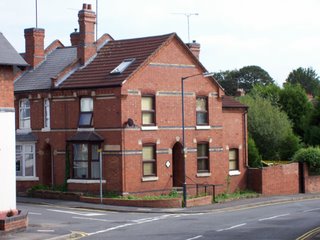Red brick is definitely the building material of choice in Kenilworth. The oldest buildings (Kenilworth Castle and St. Nicholas Church) are constructed of native red sandstone, but nearly every other building is brick—although sometimes the brick is dressed up with white stucco. Most of the brick houses in Kenilworth, I would venture to say, date from the late Victorian and Edwardian age and later. (Even our small 1990s terrace house is solid brick.) The British have a well-known penchant for taxation (the VAT, or “value-added tax,” England’s sales tax, is 17.5%), and between 1784 and 1759 there was a tax on bricks. The lifting of that tax, and the mass production of bricks beginning in the nineteenth century, led to a boom in the building of brick houses.
(Those masterbuilders, the Romans, left a large enough supply of bricks in Britain that the British were able to use recycled Roman bricks until the thirteenth-century, when the art of brickmaking was revived in Britain.)

 One of my favorite architectural touches in these late nineteenth century houses is the use of polychromatic brick. Often, black bricks are used for special effect, around windows or in a single course between the ground and first floors (top photograph, of a nineteenth-century house on the corner of Spring Lane and Henry Street in Kenilworth; click on photograph to enlarge). In Wroxall, the new owner of Wroxall Abbey in the 1860s, James Dugdale, built a row of lovely estate cottages out of this multicolored brick. The most striking building, though, is this old schoolhouse (bottom photograph), in which blue-black brick predominates. The name Wren Hall acknowledges the former owner of the Wroxall estate, Sir Christopher Wren.
One of my favorite architectural touches in these late nineteenth century houses is the use of polychromatic brick. Often, black bricks are used for special effect, around windows or in a single course between the ground and first floors (top photograph, of a nineteenth-century house on the corner of Spring Lane and Henry Street in Kenilworth; click on photograph to enlarge). In Wroxall, the new owner of Wroxall Abbey in the 1860s, James Dugdale, built a row of lovely estate cottages out of this multicolored brick. The most striking building, though, is this old schoolhouse (bottom photograph), in which blue-black brick predominates. The name Wren Hall acknowledges the former owner of the Wroxall estate, Sir Christopher Wren.


No comments:
Post a Comment